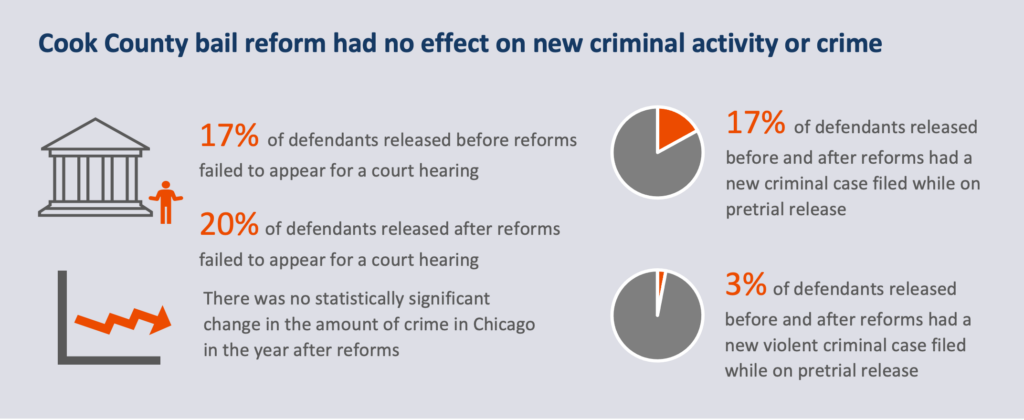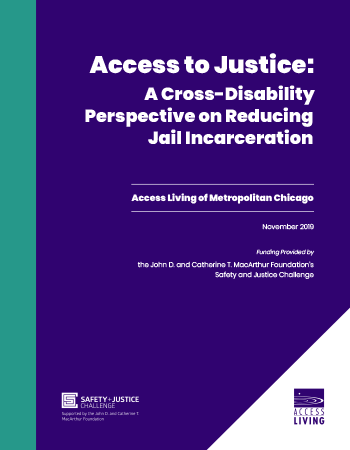Bail Data Analysis Fines and Fees January 18, 2024
January is Poverty Awareness Month in America, so it is an appropriate time to look at the early implementation of Illinois’ Pretrial Fairness Act (PFA), which eliminated cash bail for all criminal cases. It became effective on September 18, 2023, three years after its passage.
Part of the impetus for the law was to eliminate wealth-based pretrial release and detention. While the public may hear about criminal cases involving wealthy celebrities posting millions of dollars in bail to secure their pretrial release (for example Robert Durst, Bernard Madoff, Wesley Snipes, Phil Spector, and Martha Stewart all posted eye-watering bail amounts), the majority of people charged with crimes in the United States are not wealthy. More than 80 percent of felony defendants cannot afford to hire a private attorney. For many defendants, the ability to post even modest monetary bail amounts is nearly impossible. And defendants often must rely on family members, who are usually in the same financial situation as their loved one, and have to cobble together the money to secure pretrial release.
Loyola University Chicago’s Center for Criminal Justice is conducting a long-term evaluation of the implementation and impact of Illinois’ PFA, objectively assessing the degree to which the elimination of cash bail corresponds to the many predictions practitioners, policy makers, and advocates have made.
For example, some are expecting jail populations to decrease; others, however, argue there will be no change in the size of jail populations, but there will be a change in the composition of who is held pretrial as only defendants charged with serious offenses are detained. Others think jail populations may increase, as defendants who previously would have been released quickly after posting bond are now held in detention until their case is disposed. Some are predicting that failure-to-appear rates or rates of new criminal charges will increase, while others believe there will be no change or perhaps a lower rate of these negative pretrial outcomes since individuals that pose a higher risk cannot post money to be released. Our research will be testing these and other hypotheses regarding the implementation and impact of the PFA, and in time we will be able to answer these questions.
There is, however, one outcome that is guaranteed: People charged with crimes on or after September 18, 2023 will not be required to post money bail to secure their pretrial release.
Under the PFA, the majority of defendants charged with low-level felonies and nearly all defendants charged with misdemeanors must be released pretrial with or without conditions, such as supervision. Only defendants charged with specific offenses can be detained pretrial following a hearing to determine if detention is necessary to ensure public safety or appearance in court. If a court determines detention is not necessary, these individuals also must be released with or without conditions.
Prior to the implementation of the PFA, an average of 230,000 defendants were admitted to and released from pretrial detention in Illinois each year, and along with their family members they collectively posted more than $140 million per year in monetary bail. Thus, in the four months since the PFA was implemented, defendants and more likely than not, their family members, did not have to post roughly $46 million in monetary bail to secure pretrial release.
However, the PFA does more to the address the nexus of poverty, crime, and detention than just eliminate cash bail. Under the PFA, a defendant’s inability to pay for a condition of release such as electronic monitoring cannot be used as justification for pretrial detention. Previously, whether a defendant on pretrial release had to pay for electronic monitoring depended on the county where their case was being heard.
In addition, under the PFA, all defendants must have legal counsel at their first hearing when decisions about detention and release conditions are set. Previously, this was not the case in many rural counties. Like many states, criminal defense services for low income people in Illinois are provided at the county level with limited state funding. Thus, low income defendants in rural counties oftentimes did not have legal representation when bond was being determined, although they were provided legal counsel at subsequent hearings.
The lack of adequate legal representation for defendants with low incomes in many parts of the state was identified as a potentially significant impediment to the effective implementation of the PFA, particularly the requirement that defendants be represented when detention or pretrial release conditions are determined at the first appearance. To address this problem, $10 million in funding was appropriated and distributed to all Illinois counties, except Cook County (where Chicago is located), based on a funding formula that included the percent of the county population living in poverty and the volume of criminal case filings. While part of the lack of legal representation is due to the limited number of licensed attorneys in some parts of the state, the limited resources in many smaller counties also contributed to the limited defense services.
The statewide elimination of monetary bail in Illinois increases, to some degree, consistency across the state. In Illinois prior to the PFA, like most states, the decisions about who would be released on their own recognizance and the amount of monetary bail imposed were made by practitioners in individual counties. As a result, the proportion of defendants required to post bail and the bail amounts they had to pay varied considerably. In other words, a low income defendant in one county might be released on their own recognizance, while a defendant with the exact same characteristics in another county might be required to post $1,000 to secure their release, and in another county, $2,000. Observational research we did prior to the PFA’s implementation confirmed this. While it is unlikely that the general wealth of criminal defendants varied considerably, the median amount of money that defendants were required to post ranged from $1,000 to $10,000.
We also found a wide variety of reasons why criminal justice practitioners saw utility in requiring defendants to post money to secure their release beyond the intended purpose of ensuring court appearance or deterring additional criminal behavior while awaiting disposition on the current case. For example, setting high bond amounts was often seen as a more efficient means of achieving preventative detention—the goal of setting a $3 million bond for someone charged with murder was really to make sure they remain detained; however, it also theoretically says that the judge setting the bond is OK with the person being released if they can post $300,000 or 10 percent of the bond amount, which was generally required in Illinois to secure release.
Another benefit to monetary bail cited by practitioners was the assurance that, if convicted, any court-imposed fees, fines, or restitution could be immediately deducted from the money the defendant had posted. Indeed, research performed for the Illinois Supreme Court Pretrial Practices Implementation Task Force found that most bond money posted by defendants, or more realistically, their family members, was used to pay these fees, fines, and restitution. Based on interviews we did prior to the implementation of the PFA with defendants who had posted monetary bail, this practice can be a source of legal cynicism. Specifically, defendants often expressed the frustration that the money posted, and later kept, was that of family members and resulted in them feeling like the justice system is illegitimate: “Well, it makes me feel like they’re crooked and they’re only out for money.”
One of these fees is the “Bond Processing Fee,” which generated anywhere from $5 million to $17 million per year statewide in the years leading up to the PFA. Importantly, the PFA does not eliminate the ability for individuals convicted of crimes to have fees, fines, or restitution imposed, with the obvious exception of the Bond Processing Fee. What could potentially change, however, is that the imposition of these fees, fines, and restitution orders will be based on what the now convicted individual can pay, rather than how much of their family’s money is sitting in their bond account.
The ultimate impact of the PFA on rates of pretrial detention, lengths of pretrial detention, rates of failure to appear or new charges being filed during pretrial release, the degree to which defendants are quick to take plea deals to get out of pretrial detention, the sentences imposed, and financial conditions of sentences is yet to be determined. But our evaluation will answer these questions in the months and years to come. It is likely that the impact of the PFA on these outcomes will vary across Illinois’ diverse 102 counties. However, one thing is guaranteed: The ability to post a monetary bail will not be a factor that determines who is, and who is not, held in pretrial detention.










